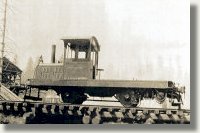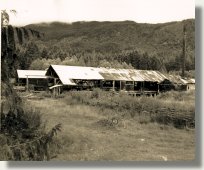
BIBLIOGRAPHY

SITE CONTENTS

LOCATION MAP

MEASURED DRAWINGS

TEACHER'S CORNER

ARCHITECTURAL
INFORMATION

DESIGN TEAM

HOME
 |
 |
| The R.B. Mclean sawmill was a family-run sawmill and logging operation. Once these kinds of businesses were fairly common, and the Northwest Coast was dotted with hundreds of similar outfits. The rapid disappearance of the smaller sawmills that used to be so widespread provided the incentive for restoring an old sawmill site. |
 |
At one time "it seemed most of the people of the Province either worked in the forest industry or were related to someone who did." (Sawmill Heritage, Volume1, no.2, p.6)
The sawmill was considered to be an export or cargo mill, and it is typical of turn of the century sawmills. The operation had two main activities, logging and sawmilling. When the sawmill was running it required fifteen men per shift. (k.d. drafting, Heritage Record Report for the Powerhouse: Mclean Mill National Historic Site, 1-4) The logging component was more modern and innovative than the mill. The changing logging methods during the life-span of the operating mill demonstrate the evolution of the forest industry. (Taylor, C.J. The Physical History of the Mclean Lumber Company Historic Site, Historical Services, Environment Canada, P. 1) In the beginning timber was logged from where it was more accessible to the creek, but this method tended to deplete the resource in one place.
 |
The Mclean Mill was especially intriguing because the mill was powered by a steam engine. Now steam power is almost obsolete: even when the mill was constructed the technology was becoming quickly outdated. |
Besides the steam-powered mill, a steam-powered locomotive brought supplies and timber in and out on a railway spur constructed from the Esquimalt and Nanaimo Railway. The original Buda locomotive engine has been restored to original condition.
A working sawmill was deeply tied to its surrounding landscape, not only because timber comes from the land, but because the ancillary geography made the whole operation work. For example, sawmills need a water area to boom logs, an area to store cut lumber, and a way of transporting lumber from the site.
PRIMARY THEMES
Logging Resources
- Donkey Boom
- Log Dump
- Gas and Oil Building
- Main Garage
- Jill Poke
Lumber Resources
- Mill
- Mill Components
- Power House
- Green Chain or Lumber Pile Deck.
- Planer Mill
- Jack Ladder
- Log Carriage
- Yard Office
- Local Office
- Burning Pit
- Conveyor
- Sawdust Storage
- Dam
- Transformer Platform
- Lumber Piling Yard
|
SECONDARY THEMES
Labour Resources
- Bunkhouse
- Middle Cabin
- Worker's Housing
- Worker's Cabin
- (Bookkeeper's)
- Main House
- Cookhouse
- Local Office Garage
Transportation Resources
- Loading Dock
- Rail Bed
- Locomotive Shed
|
Mill Pond
The mill pond was used to sort and store logs. The mill pond was built by damming the Kitsuckis Creek, and by building a stone retaining wall to pool the water. A lumber fish ladder was constructed so salmon could continue to spawn in the creek. The mill pond was used in a variety of ways simply because logs are lighter and easier to handle when they are floating.
Transport
In the beginning the Buda steam locomotive hauled the raw felled logs to the sawmill and the cut lumber from the site. Small rail lines around the lumber yard ferried logs around the site on steam donkeys. By the 1930's better roads were established and the mill started to purchase trucks and rely on automotive transport.(Chathan,Robert Archaeological Investigations and Impact Assessment p. 7)
The Main Mill Building:
The mill was the most important building on the site. "The main mill building is really a huge machine with a roof and access catwalks for the human operators. It is more than just a big shed with equipment inside. The complex system of moving power belts, steam piping, moving chains and roll casings makes it move and pulsate with energy. In fact the roof and walls are only to protect the equipment, and the people from the weather." (Sawmill Heritage, Volume1, no.4, p.3) |
 |
Power House:
The Power House was attached to the main mill building and it consisted of two adjoining buildings, the Boiler Building and the Sawdust Bin. The building is constructed of timber post and beams, wood plank floors and decks, and wood rafters and cross beams for the structure of the roof. The Boiler Building has a corrugated tin roof and two walls. The Sawdust Bin has vertical timber walls and cedar roof shingles. The Boiler Building housed the boiler and the Steam Engineer's Workshop. Sawdust from the milled logs was funnelled into the Sawdust Bin. (k.d. drafting, Heritage Record Report for the Powerhouse: Mclean Mill National Historic Site,p. 1-3)
|






